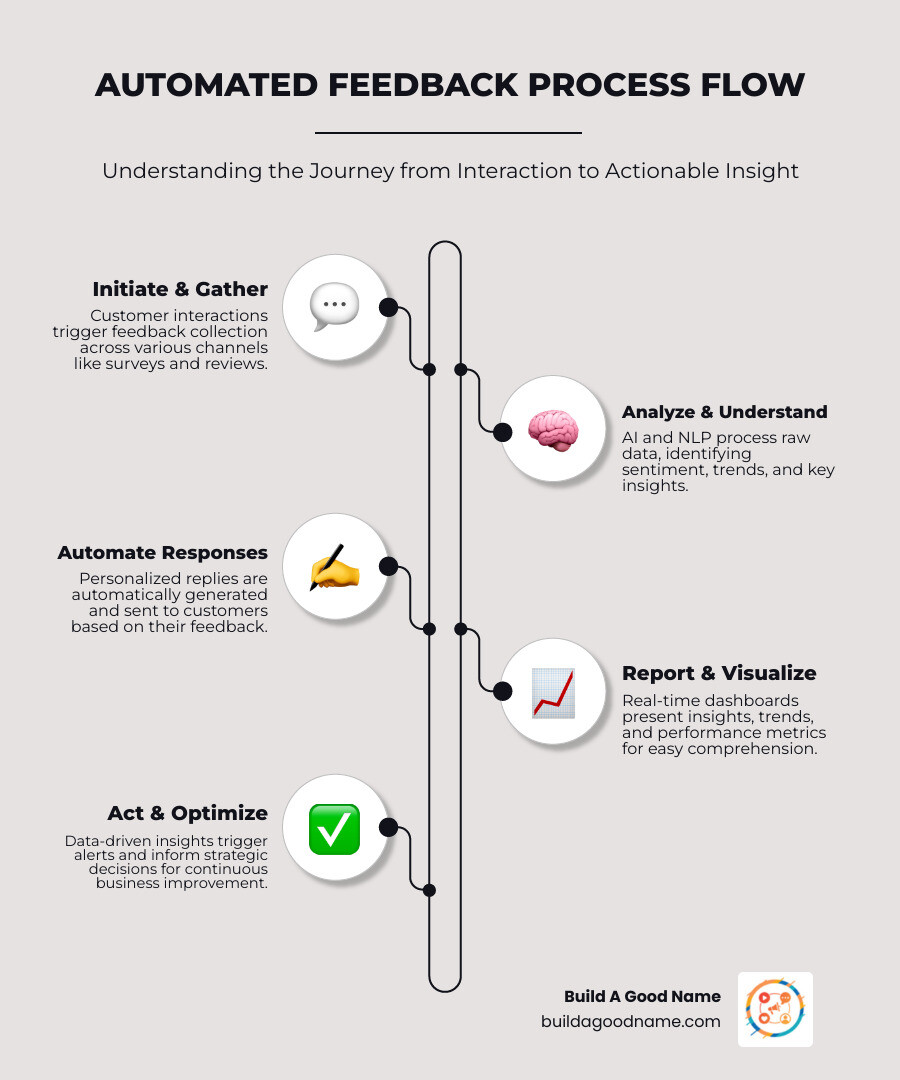Why Every Business Needs to Understand Automated Feedback Systems
An automated feedback system is a technology-driven solution that collects, processes, and responds to customer feedback without requiring constant human intervention. These systems use software and algorithms to gather insights from various sources like surveys, reviews, and social media comments, then automatically analyze and act on that information.
What automated feedback systems do:
- Collect feedback automatically through surveys, review requests, and monitoring
- Analyze responses using AI to understand sentiment and identify trends
- Send personalized responses to customers based on their feedback
- Generate insights through real-time dashboards and reporting
- Trigger actions like alerting managers to negative reviews or routing complaints
The research shows that providing detailed feedback manually is “time-consuming and difficult to scale—especially in large classes.” This same challenge applies to businesses of all sizes. Whether you’re managing 5 locations or 500, manually tracking every customer comment, review, and survey response quickly becomes overwhelming.
For busy business owners, automated feedback systems solve a critical problem: how to stay connected with customers and maintain a strong reputation without spending hours each day reading reviews and crafting responses. Studies indicate that 68% of consumers base their decisions on online reviews, making feedback management essential for business success.
The technology has evolved far beyond simple survey tools. Modern systems use artificial intelligence to understand the meaning behind customer comments, automatically categorize feedback as positive or negative, and even generate appropriate responses that sound human and personal.

Related content about automated feedback system:
How Automated Feedback Systems Work and What Powers Them
At its core, an automated feedback system is like having a super-smart assistant who never sleeps. This digital helper works tirelessly to gather and process information for you, so you don’t have to. Imagine having a dedicated team member whose only job is to understand what your customers (or students, or employees) are saying, 24/7. That’s the powerful support we’re talking about!

These systems are built to collect, process, and respond to feedback without needing constant human help. They use clever software and algorithms to look at input from many places. This includes customer surveys, product reviews, social media comments, and even school assignments. The main goal is to give you real-time insights and help you make quick, smart decisions based on solid information. If you’re curious about how our own solutions make this process easy, you can find More info about a customer feedback system that does just that. It’s all about making your life simpler!
How does an automated feedback system work?
The magic behind an automated feedback system starts with “triggers.” Think of these as the “go” signals that tell the system when to start working. These triggers kick off the process, leading to the collection of feedback through various channels, its processing, and then automating workflows based on the insights.
- Event-based triggers are set off by certain actions or important moments. For a business, this might be when a customer buys something, finishes a service call, or reaches a key step in their journey with you. In a school, it could be when a student turns in homework or finishes a lesson.
- Time-based triggers are used when you want feedback at regular times. This could mean sending a customer satisfaction survey every three months, or a quick check-in with employees each week.
- Integrations (CRM, POS, LMS) are super important. Modern systems don’t work alone. They connect smoothly with tools you already use, like your Customer Relationship Management (CRM) software, Point of Sale (POS) systems, or Learning Management Systems (LMS) in schools. This link-up allows data to flow automatically, making sure feedback requests go out at just the right time. It also helps tie responses back to the right customer or student profiles.
- Rule-based logic guides the system once feedback comes in. For example, a rule might say: “If a customer leaves a 1-star review, send it right away to a manager for a private chat.” Or, “If a student’s paper has too many grammar mistakes, offer links to helpful writing guides.”
- Real-time alerts are crucial for urgent feedback. Whether it’s a really bad review or a student struggling with a topic, it needs fast attention. Automated feedback systems can send instant alerts. This tells the right person or team to step in quickly. This proactive approach helps stop small issues from turning into big problems.
The Technology Behind the Scenes
The real smarts of an automated feedback system come from the advanced technologies that let it analyze and respond so well:
- Natural Language Processing (NLP) is the clever tech that helps computers understand, make sense of, and even create human language. When a customer writes a review like “The service was slow but the food was amazing,” NLP helps the system break down the words. It finds keywords and understands the feeling behind each part. Without NLP, an automated system would be as confused by human talk as we are by a cat’s meows (though we still love our feline friends!).
- Machine Learning (ML) algorithms are the brains that learn from data. They can spot patterns, make smart guesses, and get better and better at their job without someone telling them every single step. For feedback systems, ML helps sort feedback, guess if a customer might leave based on their feelings, and even suggest good responses. It’s like having a very quick, eager student who gets smarter with every piece of feedback it reads.
- Sentiment analysis is a special use of NLP and ML. It figures out the emotional tone of text – is it happy, sad, or just neutral? This is key for quickly seeing how customers generally feel or finding out what’s bothering them. While it’s not perfect (sarcasm can be tricky!), it gives huge insights when dealing with lots of feedback.
- Artificial Intelligence (AI) is the big term that covers NLP and ML. It allows systems to do tasks that usually need human thinking. In automated feedback, AI does everything from writing personalized replies to turning huge amounts of feedback into clear, useful information. For businesses that rely on online reviews, knowing about this technology is super important. You can Learn about AI for business reviews and see how it changes how you manage your online name. AI tools, especially those that understand language, also help students learn on their own in schools, showing how flexible this tech really is.
These technologies work together perfectly. They change raw feedback into smart, useful information. This makes your work easier and your business run more smoothly.
Key Benefits of an Automated Feedback System
Picture this: you’re running a busy restaurant, and instead of frantically checking review sites every morning (coffee in one hand, phone in the other, mild panic setting in), you wake up to a neat dashboard showing exactly what your customers thought about last night’s service. That’s the magic of an automated feedback system – it transforms the chaotic world of customer opinions into organized, actionable insights.

The real power lies in five game-changing advantages: efficiency (no more manual data hunting), scalability (handle hundreds or thousands of customers effortlessly), consistency (every customer gets the same high-quality experience), data-driven insights (make decisions based on facts, not hunches), and dramatically reduced response times (customers hear back from you in minutes, not days).
Manual feedback collection is like trying to catch raindrops in a teacup during a thunderstorm – it’s time-consuming, nearly impossible to scale, and you’ll miss most of what matters. Research confirms that traditional methods lead to “generic comments” and create an “overwhelming workload” for staff. Automated feedback systems flip this script entirely, providing “timely, individualized support” that makes the whole process “faster and easier.”
Boosting Business Performance
Let’s talk about where the rubber meets the road – your bottom line. An automated feedback system doesn’t just collect opinions; it transforms them into business growth that you can actually measure.
Improved customer satisfaction happens naturally when you can spot problems before they become disasters. These systems collect feedback at every touchpoint, from the moment someone walks through your door to weeks after they’ve left. When you catch issues early – maybe the new server is struggling, or the bathroom needs attention – you can fix them before they turn into negative reviews.
Increased retention becomes your secret weapon because automation lets you “approach customers before they churn.” Think of it as having a crystal ball that shows you which customers are getting frustrated. When someone leaves a lukewarm survey response or mentions a problem, the system flags it immediately. You can reach out with a solution before they decide to try your competitor down the street.
Here’s where things get really interesting for your online reputation. Smart systems act like a skilled traffic director, routing good feedback to public review sites like Google and Yelp, while sending negative feedback directly to you for private resolution. This “bad review gatekeeper” approach means your happy customers share their joy with the world, while unhappy customers get personal attention to fix their problems.
The impact is measurable: more positive reviews lead to higher search rankings, increased trust, more clicks, more calls, and ultimately more business. If you’re ready to see how this works in practice, you can find customer review automation that puts these strategies to work for your business.
Product development insights emerge from the treasure trove of customer comments. Instead of guessing what improvements to make, you can analyze real feedback to understand what customers actually want. Maybe everyone loves your new menu items but wishes you had more vegetarian options, or perhaps your service is great but your parking situation needs work.
Efficiency and scalability solve the “impossible math” problem. Imagine manually tracking feedback from 500 customers across three locations – you’d need a full-time team just to read everything! Automated systems handle thousands of interactions without breaking a sweat, freeing your staff to focus on what humans do best: creating amazing experiences for customers.
Changing Education and Training
While we focus on helping businesses build great reputations, it’s fascinating to see how automated feedback systems are revolutionizing education – and many of these principles apply directly to employee training programs.
Personalized learning becomes possible when systems can provide “individualized, on-demand feedback” custom to each person’s specific needs and progress. In a business context, this means your new employees get training feedback that addresses their unique strengths and areas for improvement.
Immediate feedback changes everything about learning and development. Instead of waiting weeks for performance reviews, employees can get insights “within minutes” of completing training modules or customer interactions. This rapid feedback loop helps people improve quickly and builds confidence faster.
Reduced instructor workload happens because automation handles the routine stuff – tracking completion rates, identifying common mistakes, flagging people who need extra help. This frees up your training managers to focus on the complex, human aspects of development like mentoring and strategic thinking.
Skill gap analysis becomes crystal clear when systems can identify patterns across your entire team. Maybe everyone struggles with a particular customer service scenario, or perhaps your sales team needs more support with closing techniques. These insights help you target training where it’s needed most.
The research backs this up beautifully. Studies show that automated feedback systems create more responsive, efficient, and successful environments – whether you’re running a restaurant, managing a retail chain, or training a customer service team. For deeper insights into how this works in educational settings, check out this research on automated feedback in higher education.
Overcoming the Challenges and Limitations
While the benefits of an automated feedback system are truly wonderful, it’s also important to remember that no technology is a magic wand. Leaning too heavily on automation alone can bring its own set of problems. Sometimes, it’s like asking a robot to understand a subtle wink – it just doesn’t quite get the human touch!
When we rely solely on machines, we might encounter a few common limitations. For instance, automated responses, no matter how clever, can sometimes struggle with a genuine lack of empathy, especially when dealing with sensitive customer issues. Think about a time you needed a comforting word, and instead got a perfectly worded but impersonal reply. There’s also the challenge of misinterpreting nuance; sarcasm, cultural jokes, or even a subtle sigh can be completely missed by algorithms, leading to responses that just don’t quite fit.
Then there’s the risk of over-reliance on scores. While a 5-star rating is great, focusing only on the number can make us miss the why behind it – the rich stories and feelings that explain a customer’s experience. This can lead to an impersonal experience overall, making interactions feel generic and cold, which can really chip away at that valuable human connection. And, of course, when collecting so much information, data privacy is a big deal. We need to make sure all that valuable customer data is safe, secure, and compliant with important rules like GDPR.
Balancing Automation with a Human Touch
So, what’s the secret? It’s not about ditching automation, but about embracing a smart “human-in-the-loop” model. This is a clever hybrid approach that brings together the best of both worlds. Automation handles the big, routine tasks, but any tricky, sensitive, or unclear feedback gets flagged for a real person to review. For example, if a negative review comes in with super specific, critical details, the system can automatically send an alert to your customer service team to step in and respond personally.
This way, we use automation to gather feedback and even craft initial replies, but we always keep the option for human intervention wide open. This ensures we get all the fantastic efficiency benefits without ever sacrificing quality or that crucial empathetic touch. Advanced systems are designed to be your watchful assistant, identifying keywords or unusual sentiment that practically taps you on the shoulder and says, “Hey, this one needs your special attention!” Even in automated messages, we can use personalization tokens to drop in customer names, specific product details, or mention past interactions, making each reply feel much more custom-made and less robotic. And it’s a journey of continuous learning; we constantly watch and fine-tune our automated processes, tweaking the rules or training the AI whenever something isn’t quite understood.
The big picture here is that automation is there to support your team, not replace them. It’s about empowering your business to do more, better, and faster.
Common Metrics and What They Really Mean
To truly get the most out of your automated feedback system, it helps to speak the language of feedback metrics. These scores offer quick insights into how you’re doing, but remember, they’re snapshots, not the whole story. They tell you what happened, but the qualitative feedback tells you why.
Here’s a quick look at some of the most common metrics and what they’re really trying to tell you:
| Metric | What it Measures | Typical Question |
|---|---|---|
| Net Promoter Score (NPS) | Measures customer loyalty and likelihood to recommend your business. It’s a key indicator of growth potential. Calculated by subtracting the percentage of Detractors (0-6) from Promoters (9-10). | “How likely are you to recommend [Company/Product/Service] to a friend or colleague?” (on a scale of 0-10) |
| Customer Satisfaction (CSAT) | Measures short-term satisfaction with a specific interaction, product, or service. Often asked immediately after an experience. | “How satisfied were you with [your recent interaction/product/service]?” (on a scale of 1-5 or 1-10, or using smileys) |
| Customer Effort Score (CES) | Measures how much effort a customer had to exert to get an issue resolved, a request fulfilled, or a product purchased/returned. Lower effort usually correlates with higher loyalty. | “How easy was it to [accomplish a specific task]?” (on a scale of 1-7, from “Very Difficult” to “Very Easy”) |



